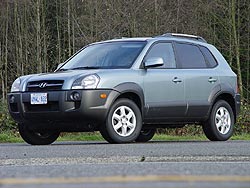 2005 Hyundai Tucson; photo by Greg Wilson. Click image to enlarge |
|
Related articles on Autos
Manufacturer’s web site
|
By Chris Chase
Find this vehicle in Autos’s Classified Ads
Introduced in 2005, the Hyundai Tucson was way late to the compact crossover party, a bash that started in 1997 when the Honda CR-V and Toyota RAV4 first flicked on the lights in what would soon become a very hip piece of the marketplace.
But like so many latecomers have proven, you don’t have to have been first in order to be good at something. While the Tucson won many sales based on Hyundai’s typical budget pricing, it also proved to be a very nicely-built vehicle for its price.
The Tucson could be had with either a 2.0-litre, four-cylinder engine (140 hp) or a 2.7-litre V6 (173 hp). The four-cylinder was available with a five-speed manual or four-speed automatic transmission, while the V6 was paired with the automatic exclusively. Naturally, all-wheel drive was offered too, but only with the six-cylinder engine.
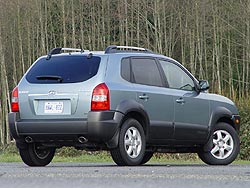 2005 Hyundai Tucson; photo by Greg Wilson. Click image to enlarge |
In 2006, a four-cylinder, five-speed manual transmission model could be had with all-wheel drive, but not with the automatic. The V6 version continued to be offered in front- and all-wheel drive. That four-cylinder, all-wheel drive model was dropped in 2007, leaving all-wheel solely to the six-cylinder models once again.
2009 models got a mild – almost indistinguishable – styling update in advance of a complete redesign for 2010.
Fuel consumption ratings in 2005 were 10.7/8.0 L/100 km (city/highway) for four-cylinder models with either transmission, while V6 models were rated 11.9/8.4 (FWD) and 12.3/8.8 (AWD). The four-cylinder’s numbers improved slightly through the model run, to finish out at 10.5/7.6 with the manual transmission and 10.2/8.0 with the automatic. The V6’s figures remained more or less the same until 2009, when its city-cycle consumption improved notably, to 11.3/8.4 (FWD) and 11.6/8.8 (AWD).
The Tucson could be a poster child for Hyundai’s constantly improving quality, earning an above-average used vehicle rating from Consumer Reports, and a spot on the publication’s used vehicle “good bet” list.
 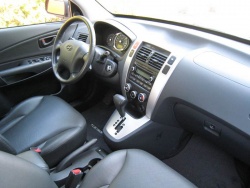 2005 Hyundai Tucson GL four-cylinder, by Haney Louka (top); 2008 Hyundai Tucson Limited FWD, by Jil McIntosh (bottom). Click image to enlarge |
Many owners report frequent dead batteries in Tucsons, a problem attributed to a radio that siphons electricity even when the car is off. Consumer Reports notes this in its reliability data on the Tucson; the publication also notes radio troubles, which I suspect are related to the same problem.
An illuminated check engine light could indicate a misfire in the engine’s ignition system, ultimately caused by a bad fuel pump or clogged fuel filter.
Also, early Tucsons had a problem with their anti-lock braking system, which would randomly activate the brakes at one wheel. This issue was covered by a recall issued in 2005.
Anecdotal information found in Internet discussion forums tends to be a good barometer of a vehicle’s overall durability, and in the Tucson’s case, it corroborates CR’s data and the magazine’s high opinion of the car.
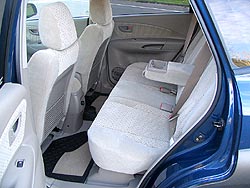 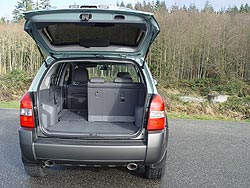 2005 Hyundai Tucson, by Grant Yoxon (top); 2005 Hyundai Tucson, by Greg Wilson (bottom). Click image to enlarge |
The Tucson earned only an “acceptable” rating in Insurance Institute for Highway Safety (IIHS) frontal offset crash tests, due to a high risk of foot injury. The Tucson wasn’t offered with side or head curtain airbags in Canada, but they were standard in the U.S. In IIHS side impact tests, a Tucson equipped with side airbags got another “acceptable” rating, due to a strong likelihood of pelvic injury for the driver and rear passenger, and so-so safety cage performance.
A similarly-equipped model was tested by the National Highway Traffic Safety Administration (NHTSA) and earned that organization’s coveted five-star ratings all around, for driver and front passenger protection in frontal impacts, and front- and rear-seat occupant protection in side impacts.
For the record, the 2006 Tucson added front-seat side airbags as standard in all trims and side curtain airbags as standard in the top-line GLS model. But in 2007, front-seat side airbags were limited to the top-line model as well. Strangely, the Kia Sportage, a mechanical twin to the Tucson, got six airbags as standard across the line from the start, despite the Tucson being the more “upscale” of the two; go figure.
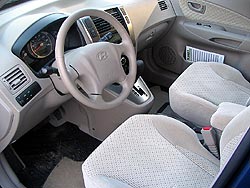  2005 Hyundai Tucson, by Grant Yoxon (top); 2005 Hyundai Tucson GL four-cylinder, by Haney Louka (bottom). Click image to enlarge |
Used Tucson values start at $9,350 for a 2005 FWD, four-cylinder model with manual transmission and no air conditioning (the more realistic figure is $10,550 for the same vehicle with auto and air). At the high end, a 2009 Limited 4WD tops out at $21,250, according to Canadian Black Book. Somewhere in the middle, a nicely-equipped GL V6 AWD – which came with leather, heated front seats, cruise control, fog lamps and metal-look interior trim – is worth $15,350. That’s a bargain compared to a 2007 Honda CR-V, which prices out at more than $24,000 with leather and that model’s four-cylinder engine (the only one available). A Toyota RAV4 from the same year is valued at just under $24,000 in Limited trim with leather and four-cylinder engine.
If you like the Tucson but also like keeping your options open, look around for a Kia Sportage which, in its second generation, was a mechanical twin to the Hyundai and was offered with many of the same extras. It was packaged differently, though, so it’s tough to compare the two price-wise, feature for feature. I’d consider them both and choose the one with the features you want at the lower price.
The Tucson appears to be a very solid choice as a used vehicle, and one I’d recommend without much reservation. As usual, look for an example that comes with a detailed maintenance history, paying close attention to the fuel delivery system. If the fuel filter hasn’t been changed since the car was new, ask the seller to have it done as a condition of the sale (and if not, have it done shortly after your purchase), and have a trusted mechanic inspect the operation of the fuel pump and the electrical system (along with a once-over of the rest of the car) for evidence of the common problems mentioned earlier on in this article.
|
Pricing
Black Book Pricing (avg. retail) March 2010:
Online resources
Recalls
2005: On certain vehicles, while cornering under conditions where Electronic Stability Program (ESP) activation may not be needed, a sensitive ESP may cause the engine to reduce power and the brake at one of the wheels to be applied without brake pedal application by the driver. This may cause the vehicle to slow and may affect the path that the vehicle is traveling. Brake application caused by inadvertent ESP activation may result in a crash. Correction: Dealers will reprogram the ESP Hydraulic Electronic Control Unit (HECU).Transport Canada Recall Number: 2005206; Units affected: 2,750 2005: On certain vehicles, the parking brake lever ratchet pawl was not properly manufactured and may damage the teeth of the parking brake lever ratchet. Damaged parking brake lever ratchet teeth may prevent the parking brake from engaging or could allow it to release after being engaged. The inability to engage, or the inadvertent release of the parking brake lever may allow the vehicle to roll while it is parked, which may result in a crash. Correction: Dealers will replace the parking brake lever assembly. Transport Canada Recall Number: 2005329; Units affected: 490 2006: Certain vehicles do not comply with the requirements of CMVSS 120. The compliance label does not contain the rim size information as required by the Standard. Correction: Dealers will install an updated compliance label. Transport Canada Recall Number: 2006293; Units affected: 27,123 2005-2007: On certain vehicles, if a small-statured adult driver, not wearing a seatbelt, is involved in a frontal or near frontal crash, deployment of the driver airbag may result in an insufficient margin of compliance as measured by the test dummy in the U.S. Government fifth percentile female Out-Of-Position test. Canadian regulations in this area differ from those in the United States and thus Canadian vehicles are not out of compliance. However, in the interest of safety, Hyundai Auto Canada is conducting this campaign in order to improve the margin of compliance with CMVSS 208. Correction: Dealers will replace the driver airbag module. Transport Canada Recall Number: 2009120; Units affected: 67,976 (includes other models) 2005-2007: On certain vehicles, the stop lamp switch may have been incorrectly installed during vehicle assembly. This could prevent proper brake lamp operation. Failure of the brake lamps to illuminate when the brakes are applied may result in the following road users being unaware of the driver’s intentions, increasing the risk of a crash causing injury or death. A malfunction of the switch may also cause the brake lamps to remain illuminated when the brake pedal is released. Additionally, a faulty switch may affect the operation of the brake-transmission shift interlock on automatic transmission-equipped vehicles so that the transmission shifter would not be able to be shifted out of Park position. It may also cause the Electronic Stability Control (ESC) light to illuminate, and it may not deactivate the cruise control when the brake pedal is depressed. Correction: Dealers will replace the stop lamp switch assembly.
Crash test results
Used vehicle prices vary depending on factors such as general condition, odometer reading, usage history and options fitted. Always have a used vehicle checked by an experienced auto technician before you buy. For information on recalls, see Transport Canada’s web-site, www.tc.gc.ca, or the U.S. National Highway Transportation Administration (NHTSA)web-site, www.nhtsa.dot.gov. For information on vehicle service bulletins issued by the manufacturer, visit www.nhtsa.dot.gov. For information on consumer complaints about specific models, see www.lemonaidcars.com. |







 Follow Autos on Twitter
Follow Autos on Twitter



